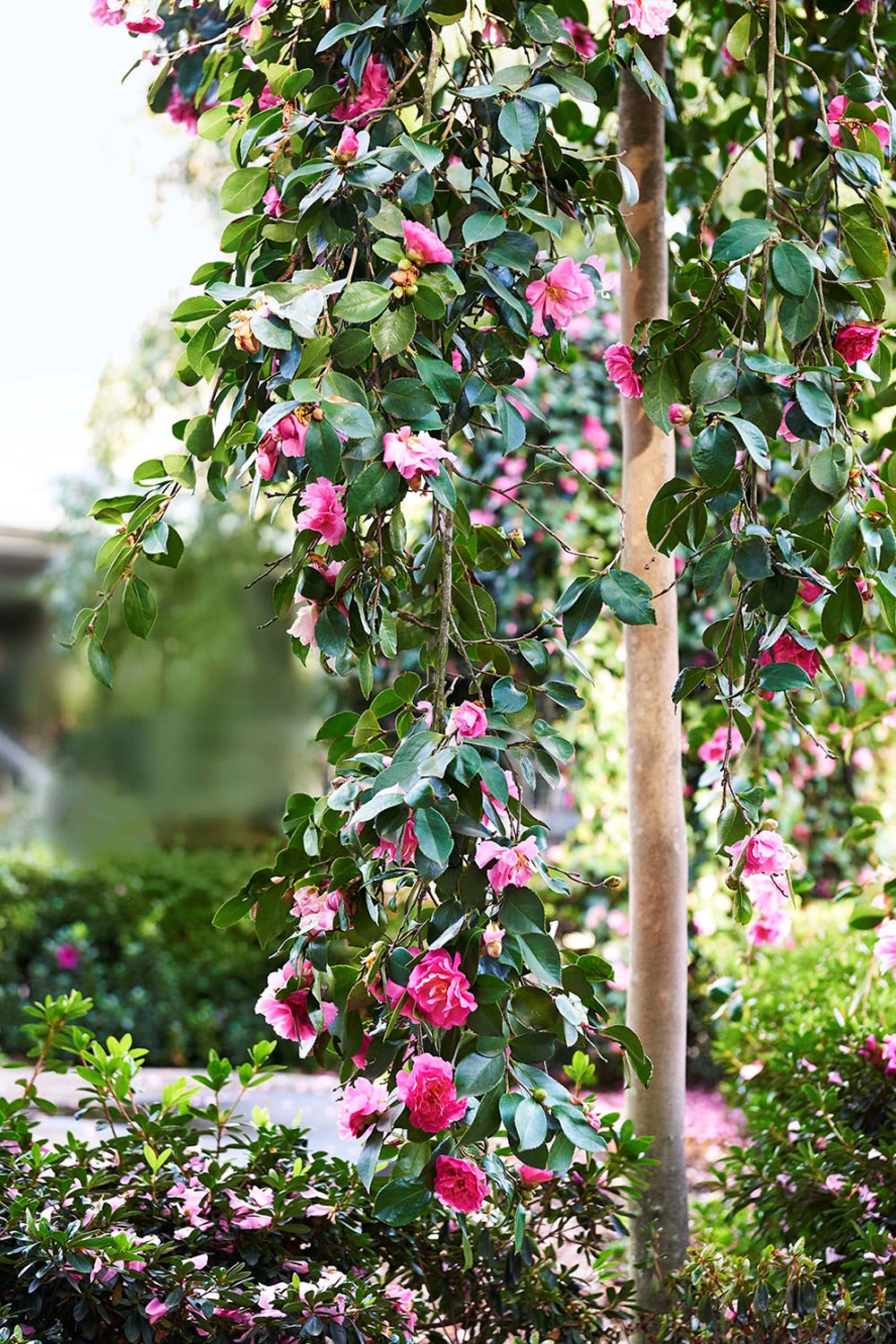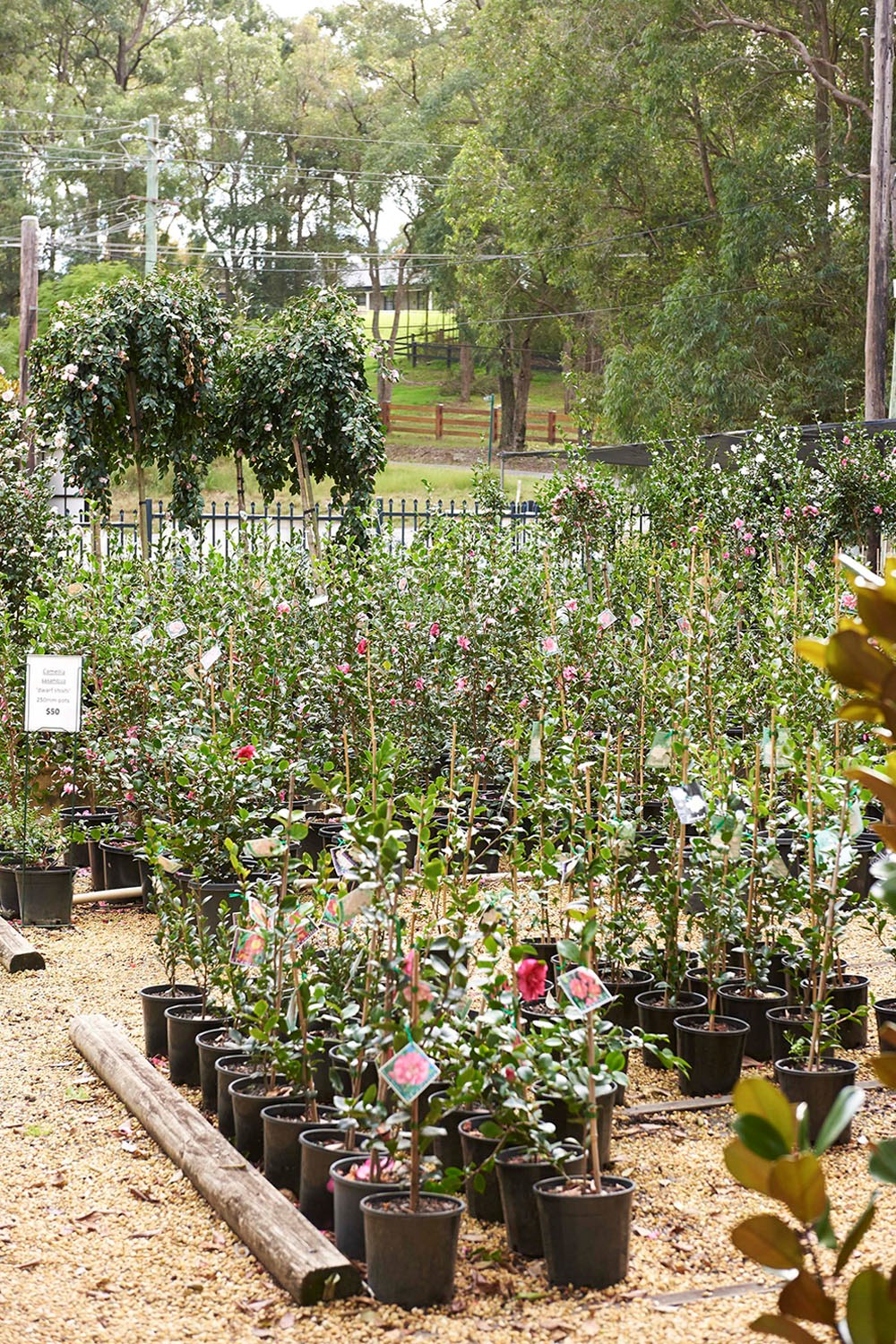How to grow camellias
Aspect
Do camellias like sun or shade? Different camellia varieties will tolerate varying levels of sun exposure, see below for more specific details.
Climate
Where do camellias grow best? Camellias grow best in mild, humid climates, but can also thrive in cold, mountainous regions. They’re not well-suited to hot, dry inland areas, but if you want to try, they will need special care: shade, humus-enriched, well-draining soil and close company of other shrubs and trees. And quite a bit of water, too.
Soil
Good drainage, prefers acidic soils.
Water
Opt for regular watering, don't let the soil dry out.
Fertiliser
Try giving your plant a good feed of Camellia-specific fertiliser.
Maintenance and pruning
Pruning of camellias can be done after flowering, but it’s only required if you want to shape them. To shape a plant, shear lightly all over and repeat during summer.
If an old plant has grown too big, you can cut it back hard to just a framework of branches. You’ll lose next winter’s flowers, but the plant will re-shoot into a smaller specimen.
How to plant camellias
- Dig a hole twice as wide as the root ball and to a depth of the pot or bag.
- Improve soil with compost or aged cow manure.
- Soak the plant in a bucket of water before removing it from the pot.
- Ease out roots that are starting to encircle the pot.
- Ensure soil around the top of the root ball is level with ground.
- Cover with leaf mulch or cow manure to a depth of 2.5cm.
- Stake for the first 12 months if in a windy spot. Remove ties so they don’t ringbark the shrub.
How to grow camellias in a pot
- If you’re growing your camellia in a pot, it will need to be potted up every couple of years as it grows.
- Don’t use containers that are too large, but pot up into pots that are just 5cm larger in diameter than the old ones.
- Tease out the roots if they are becoming bound and use fresh, top-quality potting mix (azalea and rhododendron mix is also perfect for camellias) to give it a fresh round of nutrients.
- When replanting, ensure the soil at the top of the root ball is level with the soil in the pot.
- Fertilise after repotting with water soluble or slow-release fertiliser.
- Never let the soil dry out.
- Don’t stand the pot in a saucer of water. Camellias need good drainage.
Best camellia varieties in Australia
Camellia japonica
This grows into a classic small tree - from 1cm to 4m - that prefers shade or dappled light as its large, glossy, dark green leaves can be scorched by the sun. The flowers can grow as big as 15cm and come in colours ranging from white, cream, pale to dark pink and reds with hints of orange or purple - or variegations of all.
Petal arrangements can be single, semi-double, double, or peony, anemone or rose forms. Most begin flowering in May-Jane and keep blooming through to September, and many have a dusky or almond fragrance.
The flowers stay on the plant for several weeks. Use as a formal or informal hedge, a single specimen or a feature in a mixed garden bed. It responds very well to pruning, tolerates frosts and prefers a well-drained, slightly acidic soil (pH of 6.0 to 8.0).
Camellia reticulata
‘Retics’ as they’re fondly known by camellia enthusiasts tell us that winter is almost over. With lovely, big, ruffled petals looking like skirts lifted in readiness for dancing at the spring fair, this variety of camellia grows to about 3m but the flowers between May and September are huge and flamboyant, getting up to 25cm wide, and look stunning against the deeply veined, leathery (rather than glossy), dark-green leaves.
Such a spectacle comes with a degree of preciousness, too. It needs more sunlight than C. japonica and sasanqua.
It also needs protection from wind. It fills a hole with loveliness in temperate or semi-tropical gardens, but it doesn’t like pruning. It prefers well-drained, slightly acidic soil (6.0 to 8.0).
Camellia sasanqua
This grows happily and vigorously from 1m to 5m in the sun to produce a gentler, smaller foliage than C. japonica. The flowers are smaller too, ranging from 5cm to 9cm. They emerge in late summer to mid-winter, but come in the same colours and patterns and lovely perfume.
The main difference is the flowers fall off just a day or two after emerging from the buds, creating that wondrously thick, soft carpet camellias are famous for. The fallen flowers are quickly replaced.
Grow as a formal or informal hedge, clip into a standard or topiary, craft into an espalier, make it the stand-out in a mixed garden bed, or use it as a single specimen. It responds to pruning, tolerates frosts and prefers a well-drained, slightly acidic soil (6.0 to 8.0).
How to graft camellias
If you have a favourite camellia and you’d like more either for your garden or as a gift but the variety is no longer available in nurseries, you can reproduce it with this simple trick, known as ‘approach grafting’. It’s best done in winter.
Gather your supplies
- Potted rootstock (or understock) and camellia in garden
- Clean secateurs
- Clean budding knife
- Budding tape
Here’s how
Step 1
Place potted rootstock next to your favourite camellia (mother plant).
Step 2
Remove any buds and side shoots from the rootstock with secateurs so that plant’s energy goes into growth rather than flower formation.
Step 3
Remove a sliver of wood about 2-3cm long with the budding knife from a stem close enough to the top of the bush of both the mother plant and the rootstock so that plants’ cambiums are exposed.
Step 4
‘Approach’ the stems to each other so the cuts meet.
Expert tips to make a camellia floral arrangement
Kowsh Rawson, founder of Kiko Design, known for her stunning flower bouquets shares her expert tips so you can make your own beautiful arrangements at home.
What is the best vase for camellias?
With any cut flower or stem, we always consider the height of the stem and the volume of the bunch when picking a vase. In modern floristry, we love working in thirds, so the vase should always be 1/3 the height of your stem in order for your arrangement to look balanced and in proportion. The colouring of the camellia leaf is a deep and vibrant green so choosing a complimentary colour is key!
Do camellias make good cut flowers?
Camellias make great cut flowers but do require some preparation in order to give them their best life! As the stems are quite woody, we recommend using either a hammer or a meat tenderiser if you have one in your kitchen and lightly smash the ends of your stems. This allows the water to penetrate from the opening and travel up to the flower.
How long do cut camellias last?
When appropriately prepared, your flowers can remain vibrant for up to a week.
You might also like:
Charlie Albone's spring garden tips












